Discourse analysis of some nivea advertisements
This paper presents parts of the findings of a recent study carried out with three objectives: (1) to
analyze the linguistic features of Nivea advertisements which are designed to attract customers; (2)
to discover the discourse strategies used in Nivea advertisements to construct the concept of ideal
beauty; and (3) to investigate the social implications of Nivea beauty product advertisements.
Fairclough’s three-dimension model was applied on the data sample of 18 Nivea advertisements
downloaded from the website .co.uk. Due to the length restriction, this paper only
discusses the obtained results for the first and second objectives about linguistic features and
discourse strategies in Nivea advertisements. The research results showed that in terms of lexical
devices, Nivea advertisers used both positive and negative vocabulary, scientific terms, foreign or
exotic words, second personal and possessive pronouns. Headlines are typically written in short
simple sentences and phrases while body copies tend to be longer and more complex with the use
of comparison, imperative sentences, active and passive voice, present and future tense. Other
linguistic features including the use of such rhetorical devices as repetition and simile contribute to
create impression and attraction on viewers. The discourse strategies including negative and
positive self-representation, providing scientific proof, puffery, adding appeal to healthy beauty
and setting close relationship with customers were applied to build the producers’ beauty concepts,
deliver it to customers and persuade them to use the products.
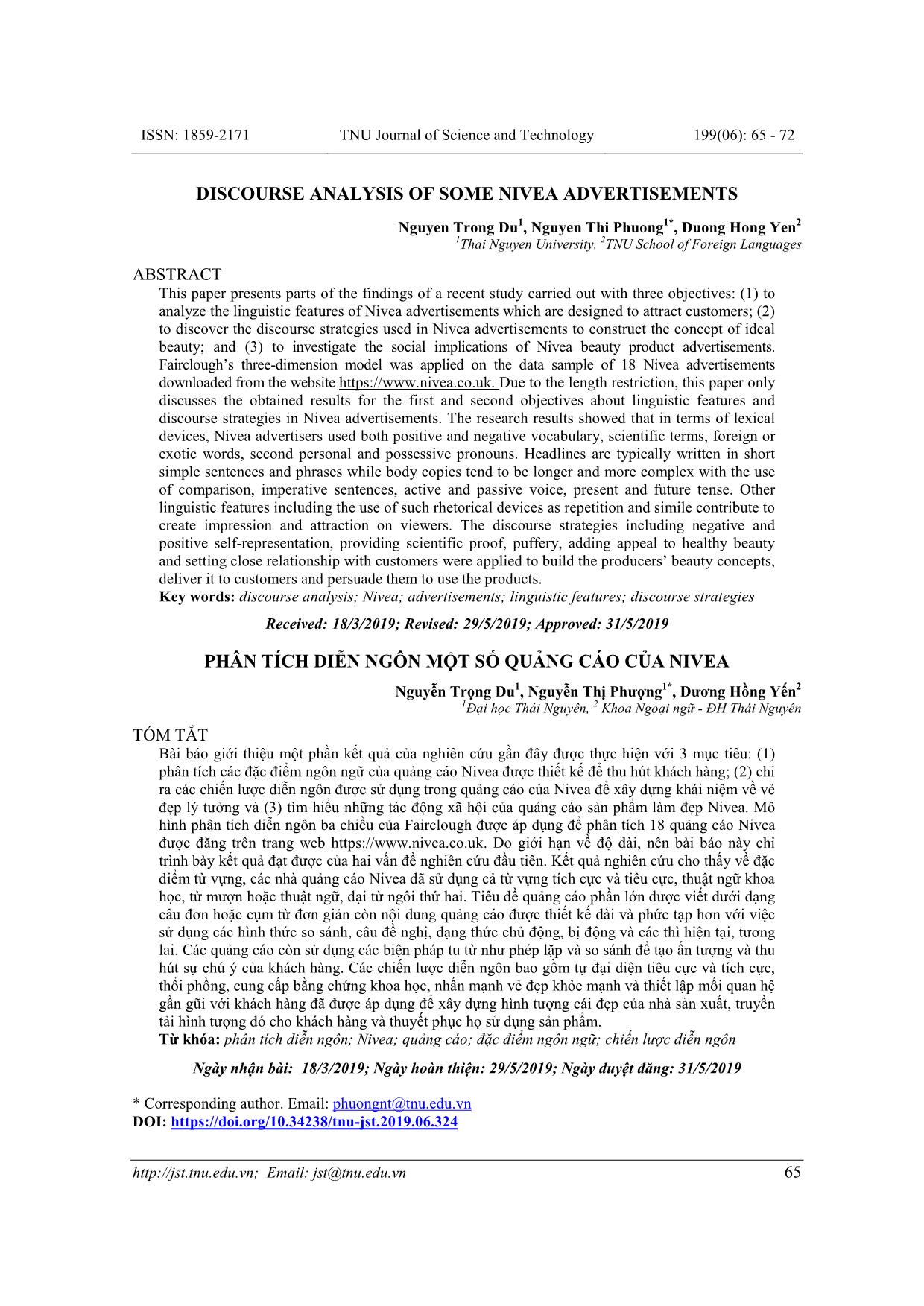
Trang 1

Trang 2

Trang 3
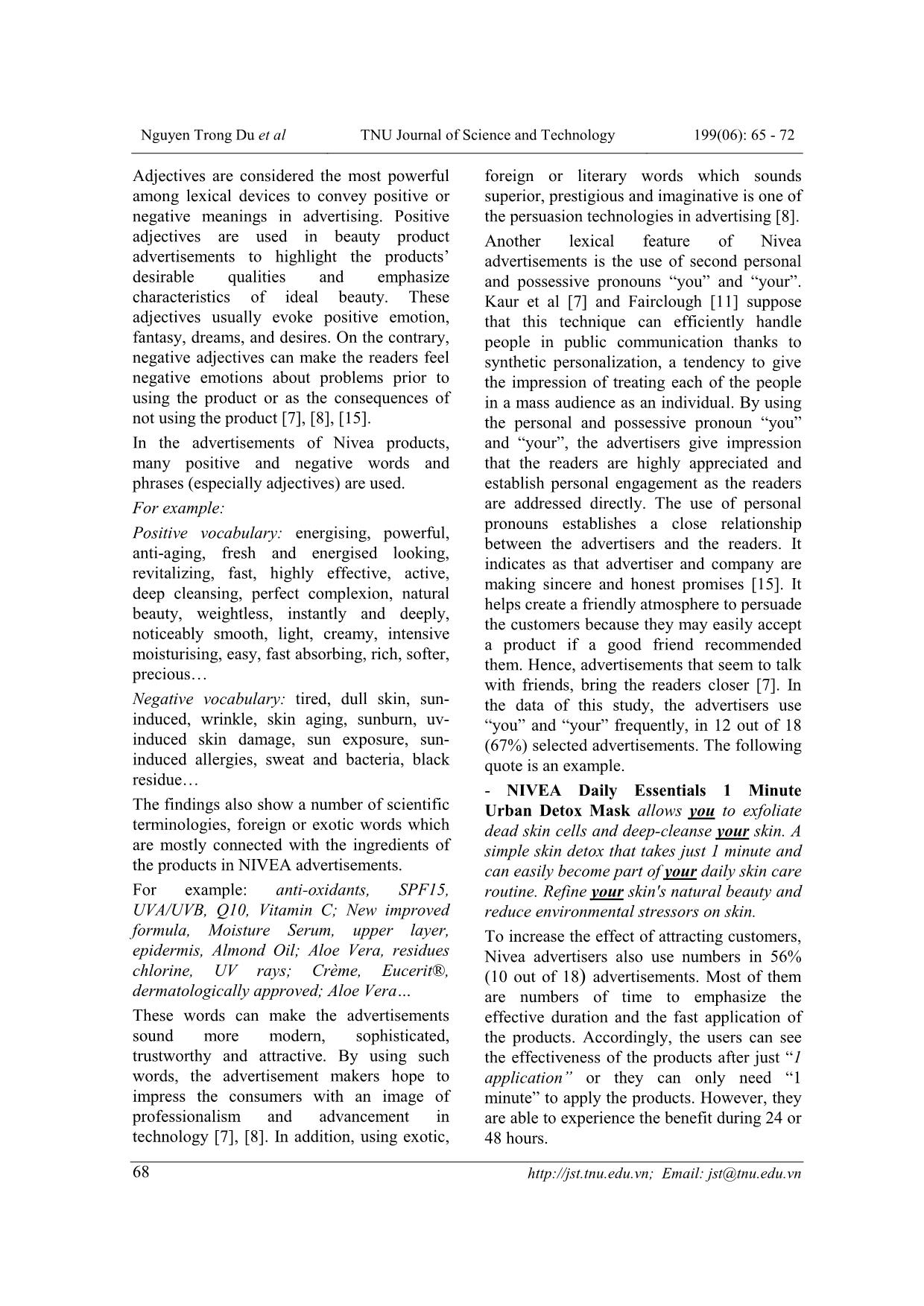
Trang 4
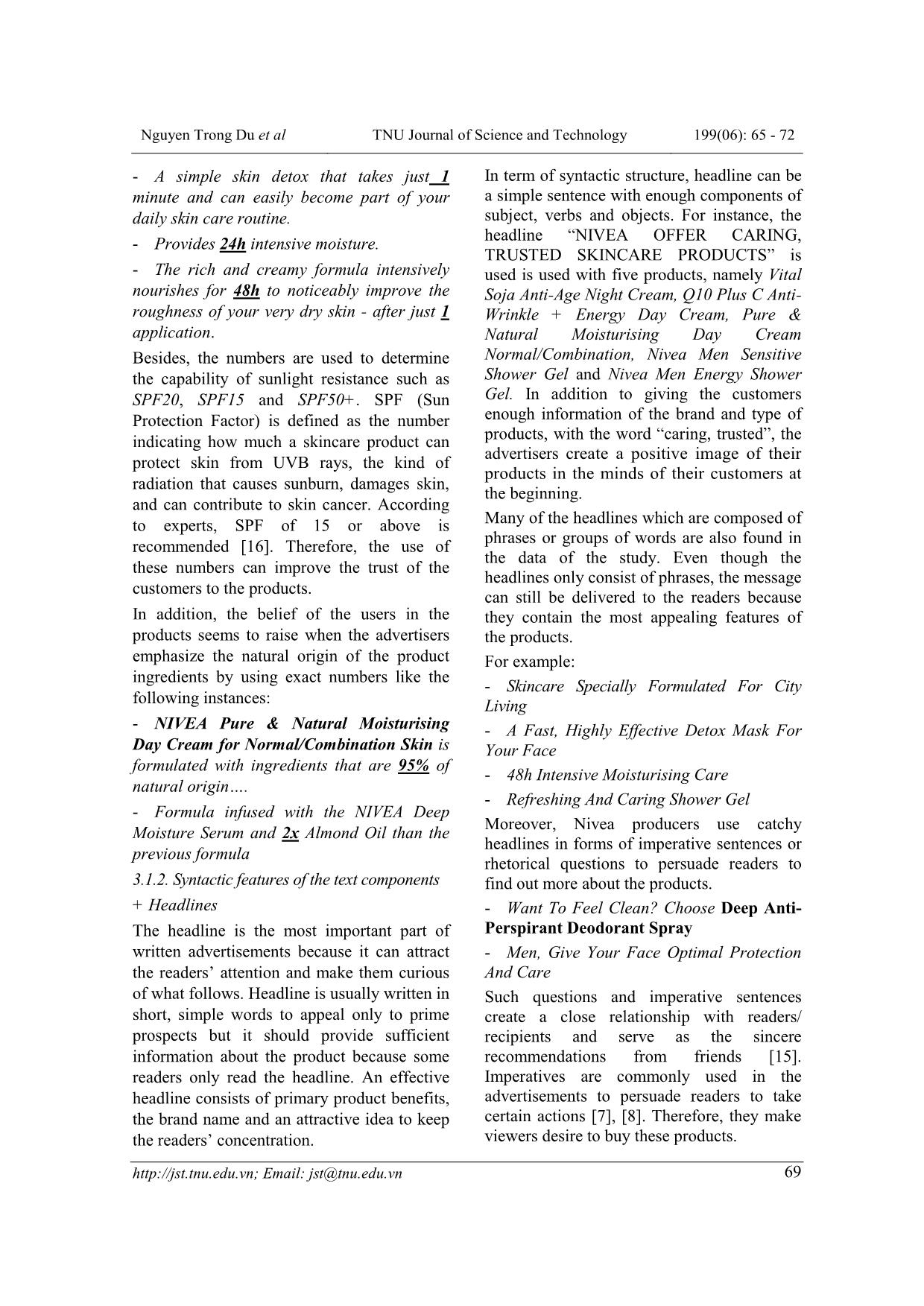
Trang 5
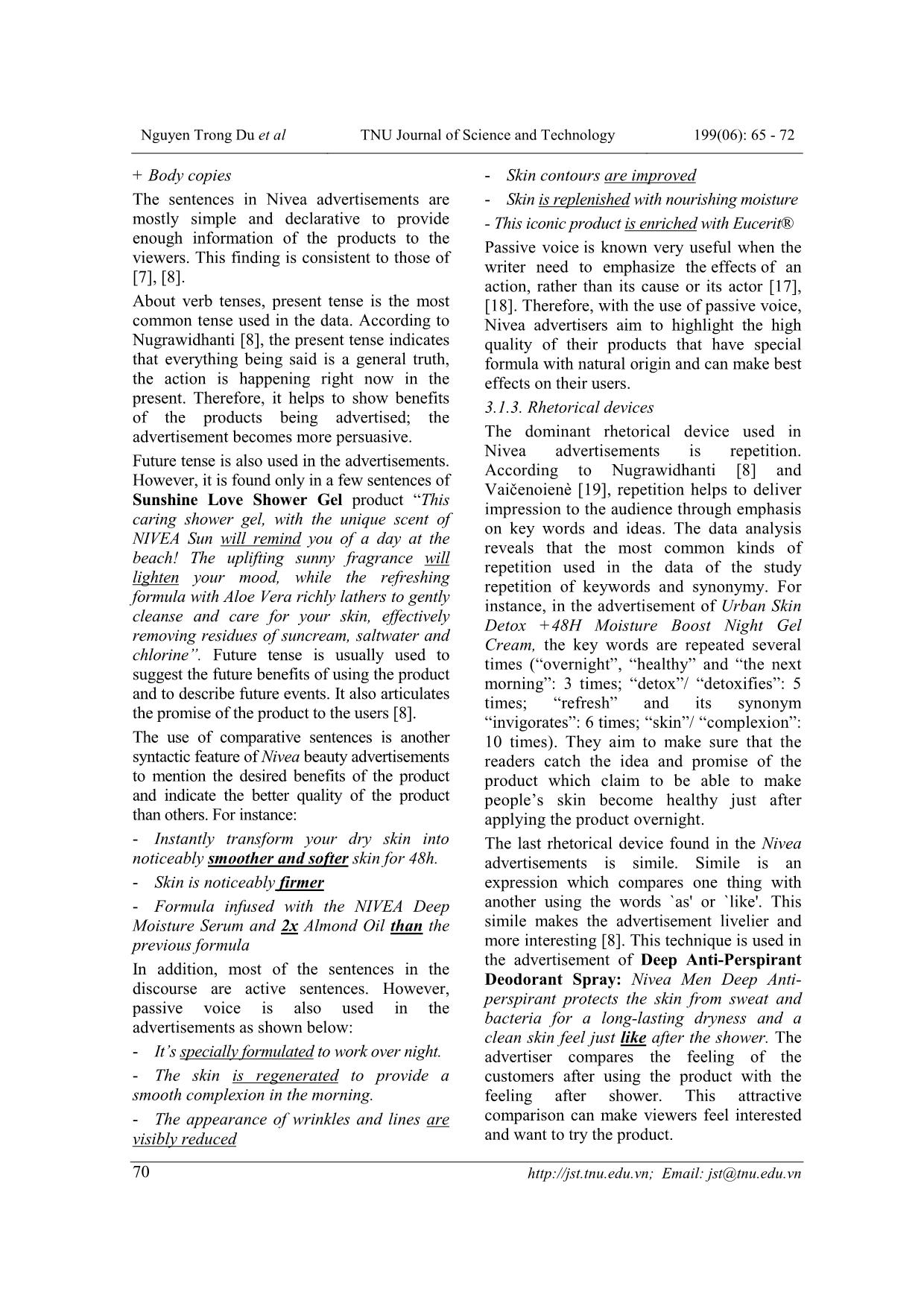
Trang 6

Trang 7
Tóm tắt nội dung tài liệu: Discourse analysis of some nivea advertisements
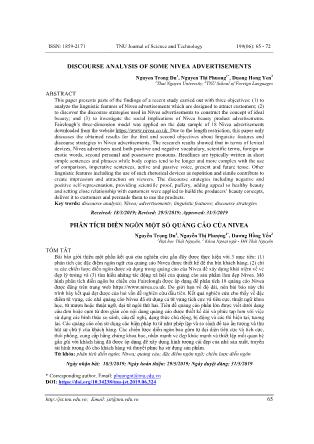
e: anti-oxidants, SPF15, UVA/UVB, Q10, Vitamin C; New improved formula, Moisture Serum, upper layer, epidermis, Almond Oil; Aloe Vera, residues chlorine, UV rays; Crème, Eucerit®, dermatologically approved; Aloe Vera These words can make the advertisements sound more modern, sophisticated, trustworthy and attractive. By using such words, the advertisement makers hope to impress the consumers with an image of professionalism and advancement in technology [7], [8]. In addition, using exotic, foreign or literary words which sounds superior, prestigious and imaginative is one of the persuasion technologies in advertising [8]. Another lexical feature of Nivea advertisements is the use of second personal and possessive pronouns “you” and “your”. Kaur et al [7] and Fairclough [11] suppose that this technique can efficiently handle people in public communication thanks to synthetic personalization, a tendency to give the impression of treating each of the people in a mass audience as an individual. By using the personal and possessive pronoun “you” and “your”, the advertisers give impression that the readers are highly appreciated and establish personal engagement as the readers are addressed directly. The use of personal pronouns establishes a close relationship between the advertisers and the readers. It indicates as that advertiser and company are making sincere and honest promises [15]. It helps create a friendly atmosphere to persuade the customers because they may easily accept a product if a good friend recommended them. Hence, advertisements that seem to talk with friends, bring the readers closer [7]. In the data of this study, the advertisers use “you” and “your” frequently, in 12 out of 18 (67%) selected advertisements. The following quote is an example. - NIVEA Daily Essentials 1 Minute Urban Detox Mask allows you to exfoliate dead skin cells and deep-cleanse your skin. A simple skin detox that takes just 1 minute and can easily become part of your daily skin care routine. Refine your skin's natural beauty and reduce environmental stressors on skin. To increase the effect of attracting customers, Nivea advertisers also use numbers in 56% (10 out of 18) advertisements. Most of them are numbers of time to emphasize the effective duration and the fast application of the products. Accordingly, the users can see the effectiveness of the products after just “1 application” or they can only need “1 minute” to apply the products. However, they are able to experience the benefit during 24 or 48 hours. Nguyen Trong Du et al TNU Journal of Science and Technology 199(06): 65 - 72 Email: jst@tnu.edu.vn 69 - A simple skin detox that takes just 1 minute and can easily become part of your daily skin care routine. - Provides 24h intensive moisture. - The rich and creamy formula intensively nourishes for 48h to noticeably improve the roughness of your very dry skin - after just 1 application. Besides, the numbers are used to determine the capability of sunlight resistance such as SPF20, SPF15 and SPF50+. SPF (Sun Protection Factor) is defined as the number indicating how much a skincare product can protect skin from UVB rays, the kind of radiation that causes sunburn, damages skin, and can contribute to skin cancer. According to experts, SPF of 15 or above is recommended [16]. Therefore, the use of these numbers can improve the trust of the customers to the products. In addition, the belief of the users in the products seems to raise when the advertisers emphasize the natural origin of the product ingredients by using exact numbers like the following instances: - NIVEA Pure & Natural Moisturising Day Cream for Normal/Combination Skin is formulated with ingredients that are 95% of natural origin. - Formula infused with the NIVEA Deep Moisture Serum and 2x Almond Oil than the previous formula 3.1.2. Syntactic features of the text components + Headlines The headline is the most important part of written advertisements because it can attract the readers’ attention and make them curious of what follows. Headline is usually written in short, simple words to appeal only to prime prospects but it should provide sufficient information about the product because some readers only read the headline. An effective headline consists of primary product benefits, the brand name and an attractive idea to keep the readers’ concentration. In term of syntactic structure, headline can be a simple sentence with enough components of subject, verbs and objects. For instance, the headline “NIVEA OFFER CARING, TRUSTED SKINCARE PRODUCTS” is used is used with five products, namely Vital Soja Anti-Age Night Cream, Q10 Plus C Anti- Wrinkle + Energy Day Cream, Pure & Natural Moisturising Day Cream Normal/Combination, Nivea Men Sensitive Shower Gel and Nivea Men Energy Shower Gel. In addition to giving the customers enough information of the brand and type of products, with the word “caring, trusted”, the advertisers create a positive image of their products in the minds of their customers at the beginning. Many of the headlines which are composed of phrases or groups of words are also found in the data of the study. Even though the headlines only consist of phrases, the message can still be delivered to the readers because they contain the most appealing features of the products. For example: - Skincare Specially Formulated For City Living - A Fast, Highly Effective Detox Mask For Your Face - 48h Intensive Moisturising Care - Refreshing And Caring Shower Gel Moreover, Nivea producers use catchy headlines in forms of imperative sentences or rhetorical questions to persuade readers to find out more about the products. - Want To Feel Clean? Choose Deep Anti- Perspirant Deodorant Spray - Men, Give Your Face Optimal Protection And Care Such questions and imperative sentences create a close relationship with readers/ recipients and serve as the sincere recommendations from friends [15]. Imperatives are commonly used in the advertisements to persuade readers to take certain actions [7], [8]. Therefore, they make viewers desire to buy these products. Nguyen Trong Du et al TNU Journal of Science and Technology 199(06): 65 - 72 Email: jst@tnu.edu.vn 70 + Body copies The sentences in Nivea advertisements are mostly simple and declarative to provide enough information of the products to the viewers. This finding is consistent to those of [7], [8]. About verb tenses, present tense is the most common tense used in the data. According to Nugrawidhanti [8], the present tense indicates that everything being said is a general truth, the action is happening right now in the present. Therefore, it helps to show benefits of the products being advertised; the advertisement becomes more persuasive. Future tense is also used in the advertisements. However, it is found only in a few sentences of Sunshine Love Shower Gel product “This caring shower gel, with the unique scent of NIVEA Sun will remind you of a day at the beach! The uplifting sunny fragrance will lighten your mood, while the refreshing formula with Aloe Vera richly lathers to gently cleanse and care for your skin, effectively removing residues of suncream, saltwater and chlorine”. Future tense is usually used to suggest the future benefits of using the product and to describe future events. It also articulates the promise of the product to the users [8]. The use of comparative sentences is another syntactic feature of Nivea beauty advertisements to mention the desired benefits of the product and indicate the better quality of the product than others. For instance: - Instantly transform your dry skin into noticeably smoother and softer skin for 48h. - Skin is noticeably firmer - Formula infused with the NIVEA Deep Moisture Serum and 2x Almond Oil than the previous formula In addition, most of the sentences in the discourse are active sentences. However, passive voice is also used in the advertisements as shown below: - It’s specially formulated to work over night. - The skin is regenerated to provide a smooth complexion in the morning. - The appearance of wrinkles and lines are visibly reduced - Skin contours are improved - Skin is replenished with nourishing moisture - This iconic product is enriched with Eucerit® Passive voice is known very useful when the writer need to emphasize the effects of an action, rather than its cause or its actor [17], [18]. Therefore, with the use of passive voice, Nivea advertisers aim to highlight the high quality of their products that have special formula with natural origin and can make best effects on their users. 3.1.3. Rhetorical devices The dominant rhetorical device used in Nivea advertisements is repetition. According to Nugrawidhanti [8] and Vaičenoienè [19], repetition helps to deliver impression to the audience through emphasis on key words and ideas. The data analysis reveals that the most common kinds of repetition used in the data of the study repetition of keywords and synonymy. For instance, in the advertisement of Urban Skin Detox +48H Moisture Boost Night Gel Cream, the key words are repeated several times (“overnight”, “healthy” and “the next morning”: 3 times; “detox”/ “detoxifies”: 5 times; “refresh” and its synonym “invigorates”: 6 times; “skin”/ “complexion”: 10 times). They aim to make sure that the readers catch the idea and promise of the product which claim to be able to make people’s skin become healthy just after applying the product overnight. The last rhetorical device found in the Nivea advertisements is simile. Simile is an expression which compares one thing with another using the words `as' or `like'. This simile makes the advertisement livelier and more interesting [8]. This technique is used in the advertisement of Deep Anti-Perspirant Deodorant Spray: Nivea Men Deep Anti- perspirant protects the skin from sweat and bacteria for a long-lasting dryness and a clean skin feel just like after the shower. The advertiser compares the feeling of the customers after using the product with the feeling after shower. This attractive comparison can make viewers feel interested and want to try the product. Nguyen Trong Du et al TNU Journal of Science and Technology 199(06): 65 - 72 Email: jst@tnu.edu.vn 71 3.2. Discourse strategies used in Nivea advertisements According to Fairclough [20], for the mass media discourse such as advertising in which the participants are separated in time and place, there is one-sidedness of this type of discourse where producers exercise power over consumers. Sutton [21, p. 68] suggests that advertisement, to some extent, will reflect some personal beliefs and values of the advertiser while it is designed to influence the viewers. The advertiser often uses several strategies in the advertisements to attract customers as well as deliver the idea of beauty. The first strategy is positive self- representation and compliment. The advertiser charms the readers by mentioning positive and negative phrases and using catchy headlines like those listed in the above part that create positive self-representation and images and make the advertisements more attractive. By drawing positive images in the readers’ mind, the advertiser stimulates the readers’ desire and persuades them to buy the product [8]. The second strategy is providing scientific evidence or clinical test proof. According to Lane et al [22], it is essential for beauty product advertisements to provide scientific proof. By mentioning scientific proof, the advertiser can remove the consumers’ doubt. This strategy is frequently used by Nivea advertisers via linguistic devices: the repetition of the statement dermatologically approved; the use of scientific terms in all selected advertisements; the use of exact percentage of natural origin, SPF or time of effect duration. Therefore, they can give impression to the readers that the product is advanced, safe and trustful. Thus, they convince consumers to believe in their promise of beautiful skin through the latest technological advances [7], [8], [20]. Another strategy is puffery which is defined as the process of making broad exaggerated or boastful statements about a product or service [23]. It is when the advertiser mentions somehow hyperbolic statements to grab attention of the readers or to make the product more attractive [8]. Puffery appears in all of the data. For example, Nivea advertise a night cream which can be able to make skin look “healthy, radiant and smooth” after one night and can keep skin moisture for 48 hours. It is considered a puffery because there is no way a cream can make people beautiful in such a short time and can keep skin humidity in such a long period. Other statements like “after just 1 application”, “precious”, “Instantly transform your dry skin into noticeably smoother and softer skin”, “Immediately protects against sun exposure” are also devices of puffery strategy in the advertisements. Those unrealistic representations and claims attract the readers to buy the product. The advertisers also use the strategy of adding appeal to healthy beauty. This strategy goes deeper into customers’ psychological aspect [8]. The advertisers try to attract the readers’ attention through personal statements about the attempt to make customers believe in the desire to be beautiful and healthy-looking. Therefore, such words as “energising”, “natural” and “healthy” are repeated several times in almost all of the research data. Besides, natural ingredients are also included in the advertisements to increase the effect of the strategy. The last strategy used in Nivea advertisements is setting close relationship with customers by using second personal and possessive pronouns and headlines in forms of questions and imperatives. The advertisers make the customers feel like they are given sincere recommendations from friends. Therefore, the effect of persuasion is improved. 4. Conclusion In short, the researcher applied Fairclough’s three-dimensional model of critical discourse analysis to analyze 18 Nivea advertisements which were hung on the Nivea main brand website [9]. After conducting analysis and discussion, the researcher has found the answers to the research questions. The first research issue is about linguistic features used
File đính kèm:
 discourse_analysis_of_some_nivea_advertisements.pdf
discourse_analysis_of_some_nivea_advertisements.pdf

